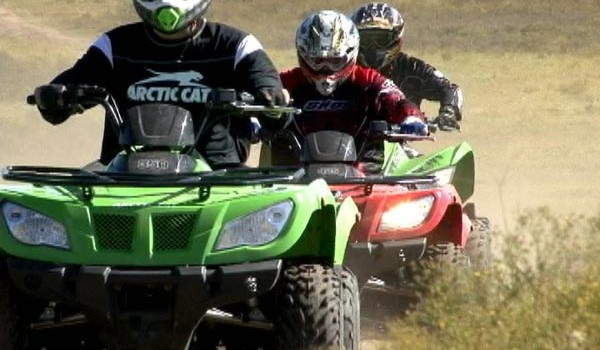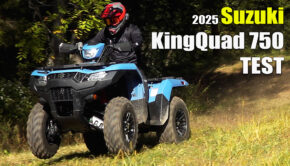2011 Arctic Cat XC450, 450 and 350 First Review:
Arctic Cat is doing a good job of keeping up with the changing economy–– shifting their focus from ATVs people dream of, like the $12,299 1000 LTD, to what consumers can afford, like their new 2011 $5,499 350, $5,999 425, and $6,699 XC 450 I sport 4×4. Along with adding more affordable machines to their line, Arctic Cat has taken some bold steps to increase the size of tier dealer network. A while back, they started partnering with Bass Pro Shops. Known for selling all types of outdoor hunting and adventure equipment, taking on a line of ATVs was a perfect move for them that put the Arctic Cat brand in front of many prospective customers who may otherwise not walk into an ATV dealership. Unlike big box hardware stores, which sell you a lawnmower but won’t work on it, Bass Pro Shops feature service centers to take care of customers when their ATVs need attention.
Technically speaking

Arctic Cat’s 366 and new 350, 425, and XC 450 are all produced through a cooperative parts sharing and manufacturing agreement between Arctic Cat and Kymco.
Arctic Cat’s 366 and new 350, 425, and XC 450 are all produced through a cooperative parts sharing and manufacturing agreement between Arctic Cat and Kymco. Where the 366 was concerned, the relationship yielded an affordable, reliable, and decent running platform, so why not build on it? All three of Arctic Cat’s new models are based on the same chassis as the Arctic Cat 366 which we finished a long-term test on last year.

Preload adjustable shocks control 7 inches of suspension travel at both ends; however, the XC features different shocks setup specifically for its sportier intensions.
All of these machines feature dual A-arm front suspension with lower A-arms and tough looking single upper control arms in the rear. Preload adjustable shocks control 7 inches of suspension travel at both ends; however, the XC features different shocks setup specifically for its sportier intensions. Arctic Cat decided to leave just a little bit of work capability in the XC as it, along with the other two machines, feature full size 2in hitch receivers and are all rated to tow up to 1050 pounds.
Looking closer at the utility machines, the 350 and 425 both received new styling for 2011. Arctic Cat moved the digital displays from the bodywork in front of the handlebars to the top of the handlebar cover. This may make strapping slightly larger items to the front racks easier, but it will make switching to an aftermarket handlebar difficult without eliminating the display. The already broad and reasonably comfortable seats received softer foam this year as well.
The 350 and 425 feature hydraulic disc brakes front and rear. The left side mounted hand lever operates the front and rear brake together, while the foot brake operates the rear brake independently.
Sharing the same chassis, both machines have mainly identical dimensions. They are both 44.5in wide with wheelbases of 48in. Both machines can haul up to 75 lbs on their front racks; 150 lbs on the rear racks in addition to their before mentioned 1050 pounds of towing capacity.
 The engine and drive train are where these two machines differ. The 350 is actually powered by the same carburetor fed, air-cooled, four valve, single overhead cam engine that powers the 366, giving you 16 extra ccs for your money. All-wheel drive replaces the 366’s original two-wheel drive / four-wheel drive setup. The full time four-wheel drive system features a limited slip front differential to help keep steering effort manageable. Its air-cooled engine and simplified drive system have the 350 weighing in at 588 pounds dry.
The engine and drive train are where these two machines differ. The 350 is actually powered by the same carburetor fed, air-cooled, four valve, single overhead cam engine that powers the 366, giving you 16 extra ccs for your money. All-wheel drive replaces the 366’s original two-wheel drive / four-wheel drive setup. The full time four-wheel drive system features a limited slip front differential to help keep steering effort manageable. Its air-cooled engine and simplified drive system have the 350 weighing in at 588 pounds dry.

The 425 trades in the 350’s smaller, air-cooled engine for Arctic Cat’s water-cooled 450 H1 power plant.
The 425 trades in the 350’s smaller, air-cooled engine for Arctic Cat’s water-cooled 450 H1 power plant. The 443cc, fuel-injected engine features four valves and a single overhead cam. This engine can also be found in Arctic Cat’s full-sized chassis 450, where it has received praise in the past from other publications for producing an impressive amount of usable power for its size. Now residing in a mid-size chassis with a 72-pound lighter dry weight, the engine has around 11.5% less mass to push around. Water-cooling and fuel injection add just a bit of weight to the 425, which weighs a claimed 613 pounds.
Last year, we tested Kymco’s Maxxer 375 and were pretty pleased with what it had to offer, although the ATV felt like it could withstand a bit more horsepower. When Arctic Cat re-branded the Maxxer into the XC, they ditched the 366cc air-cooled engine and installed their 450H1, bringing fuel injection plus a good amount of additional performance to the table. The extra performance is transferred to the ground by the same two-wheel / four-wheel drive system found on the 425.
 Besides its aggressive body styling, the XC 450 I separates itself from the 350 and 425 with its flashy aluminum wheels and low profile Maxxis tires. The wheels feature a slightly different offset adding to the machine’s width of 47.5 inches, compared to the 350 and 425’s 44.5-inch width. Its suspension has been firmed up compared to its utility siblings and the 450 is the only one of the three featuring a rear sway bar. Its front and rear brakes are operated independently by the right and left side handlebar-mounted levers. The rear brake can also be operated by the right side-mounted foot pedal.
Besides its aggressive body styling, the XC 450 I separates itself from the 350 and 425 with its flashy aluminum wheels and low profile Maxxis tires. The wheels feature a slightly different offset adding to the machine’s width of 47.5 inches, compared to the 350 and 425’s 44.5-inch width. Its suspension has been firmed up compared to its utility siblings and the 450 is the only one of the three featuring a rear sway bar. Its front and rear brakes are operated independently by the right and left side handlebar-mounted levers. The rear brake can also be operated by the right side-mounted foot pedal.
The Test

The 350’s engine comes on right off idle and it produces a good amount of torque for its displacement.
To unveil their three newest models, Arctic Cat invited us to their intro, which was held in Texas, at the Rocky Ridge ATV Park. The area offered plenty of tight challenging rocky sections along with lots of high-speed trails. We rode around all day switching off among the three machines giving us a pretty good idea of what they have to offer.
Riding the 350 is nearly an identical experience to riding the 366, which we did a long-term test on last year. The engine’s power comes on right off idle and it produces a good amount of torque for its displacement. This gets the machine rolling quickly and allows you to navigate technical sections and steep climbs more easily. The tradeoff is that the engine’s power signs off earlier and doesn’t build RPMs especially fast. Thanks to the transmission’s high and low ranges, it feels like a capable worker and decent trail explorer.

Although having no sway bar gives the little cat a fair amount of body roll, it is still relatively stable through the turns.
The 350’s handling is happiest when being cruised around or picking its way through a nasty rock section. Steering effort on the 350 seemed reasonable for a full time four wheel drive machine, thanks to its limited slip front differential. We did notice some steering feedback on uneven bumps, but nothing unmanageable. Although having no sway bar gives the little cat a fair amount of body roll, it is still relatively stable through the turns, unless you start riding it like a sport quad. If there is available traction, pushing it hard will result in two wheeling instead of a power slide thanks to its all wheel drive and small displacement engine.
On side hills and crawling its way through extremely uneven terrain, the 350 feels sure-footed and stable. Being easy to navigate also greatly enhances your control in difficult terrain.
 Suspension settings are pretty well in line with the rest of the machine, working best in technical situations. Picking your way through rocks and uneven bumps, the shocks do a very good job of absorbing uneven slow speed impacts. This is due greatly in part to the machine’s lack or a rear sway bar. As your speeds pick up, the shocks continue to do a decent job of dealing with the trail. They can happily absorb a few feet of air, but feel just a bit harsh on whooped-out sections or square-edged holes.
Suspension settings are pretty well in line with the rest of the machine, working best in technical situations. Picking your way through rocks and uneven bumps, the shocks do a very good job of absorbing uneven slow speed impacts. This is due greatly in part to the machine’s lack or a rear sway bar. As your speeds pick up, the shocks continue to do a decent job of dealing with the trail. They can happily absorb a few feet of air, but feel just a bit harsh on whooped-out sections or square-edged holes.
Braking performance on the 350 is decent, but we still wish that the lever had a more positive feel to it. Being able to operate the rear brake independently is a plus and the engine braking system is a big benefit still not found on all automatic 4×4 ATVs.

the 425’s fuel-injected engine produces significantly more thrust from a dead stop on compared to the 350.
Obviously, riding the 425 is almost identical to riding the 350; however, there are a few significant differences. First of all, the 425’s fuel-injected engine produces significantly more thrust from a dead stop on. It builds RPMs faster and feels more responsive at all speeds when the throttle is cracked. The extra power is a benefit no matter your intentions and it makes the 425 more entertaining to ride.
The extra performance of the 425’s engine puts power slides well within reach. Being able to break the rear end loose before the machine two-wheels, enhances its sporting appeal! While it weighs 25 pounds more than the 350, the extra power makes the 425 feel more nimble.
Having the ability to switch the 425 in and out of four-wheel drive on command is a great benefit we wish Arctic Cat had left on the 350. However, with its sportier engine performance, a lack of two-wheel drive would have been a bigger detriment to the 425. Arctic Cat switched out the 366’s tires for a set of Kendas, which offered better directional control and improved traction in all conditions on both machines.
Both the 350 and 425 are pretty comfortable and quite spacious for mid-sized machines. Based on our experience with the 366, we would expect them to hold up. The fuel-injected 425 is $300 less than Yamaha’s carbureted Grizzly 350. Although, to the Yamaha’s credit, it does feature a locking front differential. Both Arctic Cats, the 350 or 425, are good values; but for only $500 more than the 350, our money is on the 425.

Look out Yamaha Wolverine, Arctic Cat’s 450 H1engine gives the XC 450 I the extra horsepower Kymco’s Maxxer 375 has been needing.
Look out Yamaha Wolverine, Arctic Cat’s 450 H1engine gives the XC 450 I the extra horsepower Kymco’s Maxxer 375 has been needing. That extra power is available throughout the RPM range. Combined with far superior throttle response, the XC 450 is a lot of fun to ride and is notably more entertaining on fast wide-open trails.
Arctic Cat wisely retained both high and low ranges in the transmission. Some sport 4x4s feature only high range. We like the good low speed and work capabilities provided by having a low range option
Steering effort on the 450I felt comparable to the narrower 425, but we noticed a bit more bump feedback. Arctic Cat and Kymco should be able to remedy this somewhat without the expense of power steering. The rear sway bar greatly reduces body roll allowing it to perform much like a solid axle machine through aggressive high-speed turns. The 450 I is also extremely sure-footed on steep climbs, descants, and on side hills, boosting rider confidence. Its stable predictable feeling is due to the low profile Maxxis tires which work well on year-round trail conditions, but will have you looking for four-wheel drive often during the wet months.

The XC’s sport-tuned suspension provides a firm, yet forgiving, ride over small trail ostriches and will stand up to a few feet of air.
The XC’s sport-tuned suspension provides a firm, yet forgiving, ride over small trail ostriches and will stand up to a few feet of air without complaint. However, on square-edged bumps, the front shocks feel a bit harsh. We felt the rear shocks performed a bit better overall providing a slightly more forgiving ride. The extra ground clearance provided by the IRS is a big benefit not enjoyed by some of the Cat’s competitors.
We beat up the Kymco with no major issues, so we’d expect the Arctic Cat to last a long time. Our biggest complaint with the Kymco was a low-mounted CVT vent, which allowed the belt to get wet if water reached the bottom of the seat. The issue seems to have been fixed on the Arctic Cat.
The XC 450 I is the only fuel-injected, single cylinder Sport 4×4 on the market. It is also the only Sport 4×4 on the market with IRS, besides the $8,049 Can-Am Renegade 500 and $9,899 Renegade 800. Those extra features come at a price, though, as the Arctic Cat costs $300 more than the Yamaha Wolverine 450 or Polaris Scrambler 500. The features you get for the money, though, make the XC 450 I a good buy.
Arctic Cat is clearly paying attention to the market and they have responded with three great new choices to meet the demands of today’s ATVing enthusiast.
For more information on Arctic Cat ATVs, log on to www.arcticcat.com.











